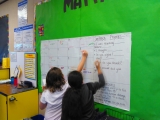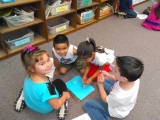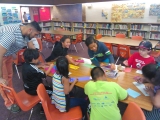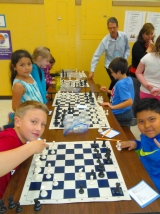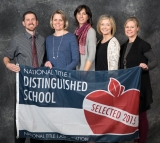-
Category 2
Selected in 2015
-
Grades: k - 6
School Setting: suburban
Town Population: 93,000
Student Enrollment: 470
Student Demographics:
Black/African American: 2%
Teacher/Student Ratio: 1:26
White/Caucasian: 37%
Hispanic: 56%
Hawaiian/Pacific Islander: 0%
Asian: 1%
Native American: 0%
Other: 4%
% Reduced Lunch: 100%
% ELL Learners: 35%
Founded: 1971 -
PRINCIPAL:
Justin Welch -
CONTACT:
535 NW Darnielle Street
Hillsboro, OR 97124
503-844-1660
welchj@hsd.k12.or.us
W. Verne McKinney Elementary School
Hillsboro, OR
School change comes from building on the strengths of the stakeholders. Lasting, meaningful change also occurs slowly. When you build upon what people are already doing well, you can leverage this positive momentum into effecting change in areas that need real improvement, while at the same time, honing those strengths to be even more effective.
- Describe specific programs in place to ensure that families are involved in the success of your school and students.
- We have a Parent Teacher Organization that works with teachers to provide supports in the arts, with field trips, supplies, and volunteers. This is really a key avenue for uniting parent efforts and school efforts in improving student achievement. Parents also volunteer for, and run, our food pantry and clothing closet.
- Describe the most successful activity your school has initiated to strengthen ties to your community.
- At McKinney, we are always on the lookout for new ways to support our community. For example, we have family literacy and STEM nights, festivals, and other fun events. In addition to these special activities, we run an on-site food pantry that gives families extra support with those important basic needs. At the same time, we are expanding our family outreach with a Family Resource Manager who facilitates parenting support and early childhood literacy. This has led to beginning a preschool for our families that we will house in one of our portable classrooms.
- Describe your philosophy of school change or improvement.
- I believe that school change comes from building on the strengths of the stakeholders. Lasting, meaningful change also occurs slowly. When you build upon what people are already doing well, you can leverage this positive momentum into effecting change in areas that need real improvement, while at the same time, honing those strengths to be even more effective. This is my approach for teachers, students, and families.
- What are your school’s top two goals for the next year?
- Find ways to increase inclusive practice for traditionally underperforming student groups and to increase teacher capacity at integrating English Language Development into all their instruction.
- What is the single most important factor in the success of your school that others could replicate?
- Providing additional learning time beyond the school day. Students who are behind in their academics need more time to catch up. The school needs to provide this opportunity in a way that works for their families. One of the most important ways to make this effective is to make sure that transportation is provided.
- Describe the program or initiative that has had the greatest positive effect on student achievement, including closing achievement or opportunity gaps, if applicable.
- We have been able to provide additional, viable and sustained learning opportunities for many of our most at-risk learners. Three days each week, we have students stay at the school to access computer programs that give additional Math and Language Arts practice. We have five staff members who make sure students are progressing during this opportunity, and giving additional instruction when students need it. During the summer, we have been able to provide six to eight weeks of additional learning opportunities for students involving STEM instruction as well as reading. These extra learning opportunities are prioritized for migrant students, students of poverty, and English Language Learners.
- Explain how Title I funds are used to support your improvement efforts.
-
We use Title I funds to pay for our instructional coaches. These leaders are instrumental in making sure our professional development is accessible and sustained in our classrooms. Since paying for teachers is expensive, this is where the bulk of our funding goes, but it is very worth it. We also use this money to pay for our family nights where we celebrate the hard work students do in Language Arts and STEM.
We also use this money to pay for our bilingual assistants to support our families who do not speak English at events and activities (such as PTO meetings). - Identify the critical professional development activities you use to improve teaching and student learning.
- As a leadership team, we meet to discuss the most pressing needs for professional development based on our overall School Improvement Plan. Twice a month, the whole faculty works together on our targeted professional development. Currently, we are working on providing language scaffolds for students in the form of GLAD strategies (Guided Language Acquisition Design), improving mathematical discourse, and how to use five types of writing effectively. We organize this work in an interactive notebook for teachers and teachers use these with their students. This is an AVID strategy (Achievement Via Individual Determination) that our district is streamlining K-12. Our most important work lies in those co-created tools that teachers use to integrate English Language Development into our content areas and shelter their instruction for students with language needs.
- Describe how data is used to improve student achievement and inform decision making.
- Our school shares one PLC data sheet in a Google Sheet. Each teacher updates certain data points that we track school-wide so we can measure student growth. This information can be accessed by any teacher in the building so that we can collaborate on achievement for EACH student, rather than teachers work in isolation on solely their own class.
- Describe your school culture and explain changes you’ve taken to improve it.
- Our school culture is one where students and teachers have the confidence and support to take risks. We began the year discussing the value of making mistakes and how the ability to make a mistake and learn from that is the most important element to a successful learning environment. Teachers take their professional development and immediately try to add it into their classroom instruction rather than ignore new ideas. Then they collaborate with teammates to decide what went well and how we can continue to refine these new practices so that they benefit students even more. Evidence of teachers implementing effective instruction is all over our walls. At McKinney, we have "tools, not decorations". Students can access scaffolds that they co-created with their teacher in all of their content areas. We constantly look for ways students take ownership of their own learning.
Stats
-
Category 2
Selected in 2015
-
Grades: k - 6
School Setting: suburban
Town Population: 93,000
Student Enrollment: 470
Student Demographics:
Black/African American: 2%
Teacher/Student Ratio: 1:26
White/Caucasian: 37%
Hispanic: 56%
Hawaiian/Pacific Islander: 0%
Asian: 1%
Native American: 0%
Other: 4%
% Reduced Lunch: 100%
% ELL Learners: 35%
Founded: 1971 -
PRINCIPAL:
Justin Welch -
CONTACT:
535 NW Darnielle Street
Hillsboro, OR 97124
503-844-1660
welchj@hsd.k12.or.us



